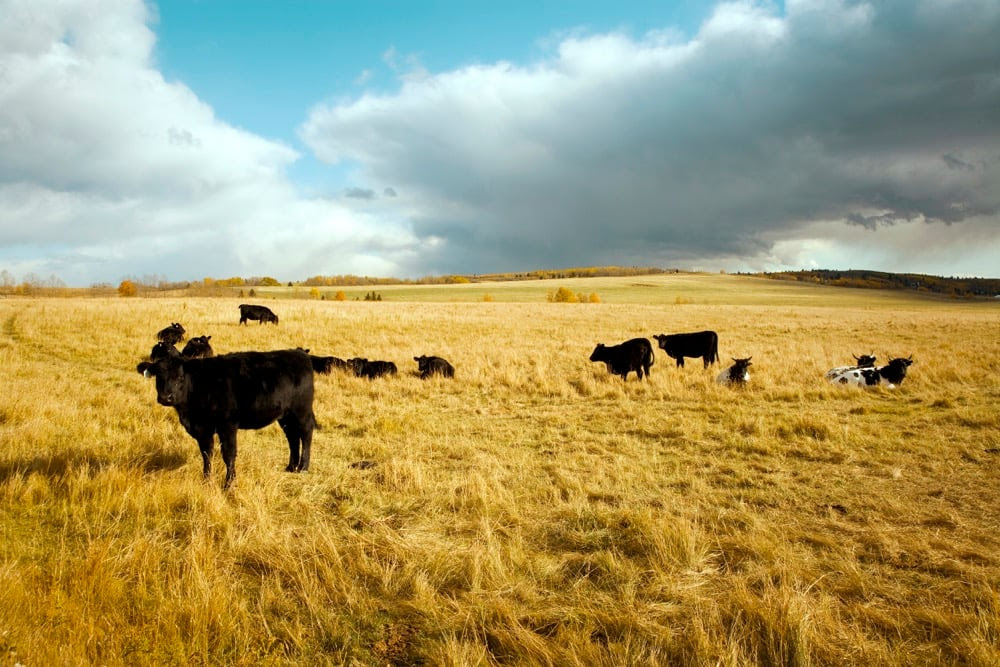Originally published on May 22, 2024 on Canadian Cattlemen
By Gabriel Ribeiro and Contributor
With the grazing season starting across the country, producers should ask whether they are making the most of it. The grazing season in Canada is brief — depending on where you are, it can be four months or less. However, a well-planned and managed grazing season — focused on maximizing forage growth/production, adequate grazing management and appropriate mineral supplementation — can reduce production costs and increase profitability. With this column, I want to focus on transitioning yearlings from confinement into spring pasture, to make the most of the grazing season.
The transition from winter feeding in confinement to pastures can be a stressful period for calves, slowing growth and even causing body weight losses in the first month. This stress is triggered by the transport of yearlings to pasture, forming new groups, the new environment and the abrupt change in diet, altering ruminal conditions. There is a lot of research focused on minimizing stress while receiving cattle in the feedlot, but not much research has been done looking at this transition of yearlings from winter feed to grazing lush, green pastures.
Considering the short grazing season, these losses of gain or body weight in the first month can have significant economic consequences for producers. After turning cattle to spring pastures, we often see animals with loose manure or runny feces. Body weight losses on average of about five per cent have been reported shortly after turning yearlings to spring pastures, with animals taking up to four weeks to recover to their starting weight. This transition stress — associated with an abrupt change in the diet of calves to the high moisture (85-90 per cent), high protein (15-20 per cent) and low fibre content of spring pastures — can promote reduced dry matter intake and a faster diet passage rate through the digestive tract, leading to losses in gut fill, body water and muscle tissue.
Minimizing stressful events during this transition can reduce body weight loss and shorten the period that it takes for cattle to start gaining weight on pasture. Low-stress cattle handling and transporting during the cooler periods of the day can help. It has also been shown that cattle fed to achieve high rates of gain (2.5 to three pounds per day) during confinement lose more weight when turned out to pasture compared to more moderate gains (around two pounds per day). Increasing silage/hay and decreasing grain in the diet of cattle in confinement can ease this transition to pasture and prevent losses. This will lead to changes in the microbe population in the rumen, promoting the establishment of a microbial community better able to digest forages when grazing.
Starting yearling on grass pastures that have a lower percentage of legumes may also prevent body weight losses and promote adaptation to legumes. Then progress cattle through paddocks/pastures with increasing percentages of legumes (i.e. alfalfa) over time. This way cattle not only have an opportunity to adapt to legumes in the diet, but the bloating potential will drop in the legumes as the plants mature.
Additionally, providing good quality water and making sure adequate mineral supplements are easily accessible will be essential to promoting yearling growth on pasture. The mineral supplement should be specific to yearlings grazing spring pastures, considering the pasture’s composition (i.e. legume versus tame grass versus native grass).
To optimize the growth performance of yearlings and maximize pasture production, it is also essential to consider when to start the grazing season, as well as the carrying capacity of pastures. It is recommended that pasture only be grazed once it reaches a height of four to six inches and has a minimum of 1,000 pounds of dry matter per acre available. Putting cattle on pasture too early can severely reduce pasture availability later in the season. For example, it is estimated that the commencement of grazing one week too early will reduce the grazing season by three weeks in the fall. As pasture growth declines over the grazing season and into the summer, consideration should be given to decreasing stocking density to prevent a reduction in the amount of forage available to cattle, as well as overgrazing, which will reduce the long-term productivity of the pasture.
Making the most of the grazing season requires a deep understanding of the interactions that occur between the animal, its gut microbes, forage composition, forage growth and the environment. Failure to appreciate the intricacies of any one of these components can result in poor gains as well as possible long-term negative effects on pasture productivity.

